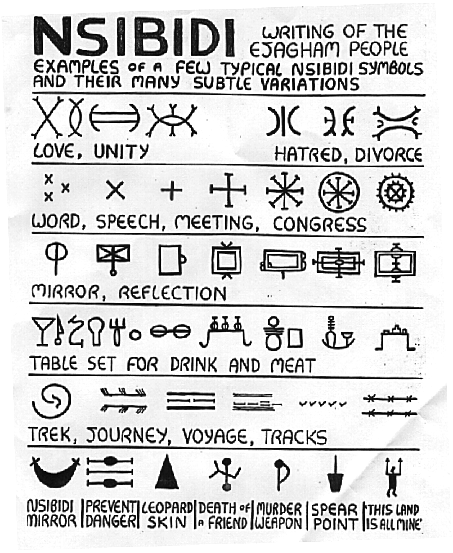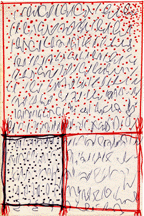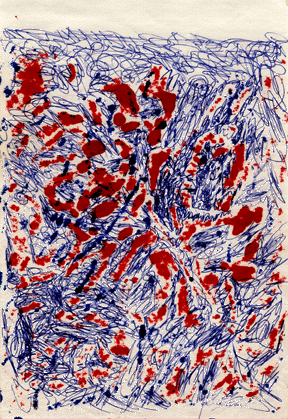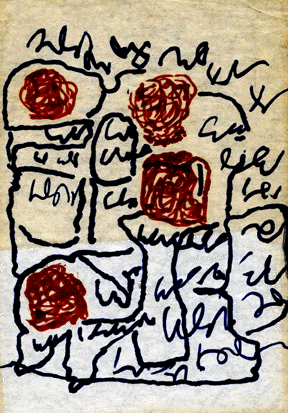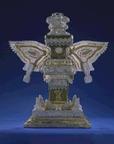 Ideas |
Earlier ThinkingMs. Lynda Hartigan of the National Museum of American Art, Smithsonian, Washington D.C., USA, has written much of what is available on James Hampton and the Throne. In a private e-mail of October 15, 1998 to the author, she said, "At this point in time, it is widely believed that the script is the visual equivalent of speaking in tongues or a variation on the African-derived tradition of spirit writing, recognized but not necessarily readable in the classical Western sense by those of comparable spiritual calling. "As we shall see, Hampton writes what are obviously the same "words" at corresponding spots in two different drawing of tablets of the Ten Commandments. This shows that it is very unlikely that his writings are the visual equivalent of speaking in tongues. To date the author has seen only one article on African-derived spirit writing, Harryette Mullen's "African Signs and Spirit Writing". This article mentions native African writing systems as well as the visual equivalent of speaking in tongues. Specifically she quotes an article by Maude Southwell Wahlman (Wahlman 1987), "... In the New World various mixtures of West African (Vai) and Nigerian (Nsibidi) scripts and the Kongo cosmogram fused to create numerous new scripts." (p. 675) Cornell University's List of African Scripts shows the Vai Syllabary of Liberia and the ideographic Nsibidi writing system of the Ejagham people of Nigeria . The Cornell site notes: "... charts for Nsibidi and the Vai syllabary are from Maude Wahlman's book Signs and Symbols: African Images in African American Quilts." However, in a private e-mail to the author of Jan 16, 2001, Dr. Maude Southwell Wahlman said: "I'm afraid that you are making too big a jump between the scripts being in my book and assuming that they were woven into quilts. They were not. West Africans had traditions of protective writing, and used abstractions from numerous writing systems in textile designs. The idea of protective writing survives many places in the New World, and is seen in many textile and charm traditions. "I am familiar with James Hampton's work, but do not consider him an outsider artist, as he continued graveyard art traditions from his home in Eloree, SC, where light bulbs and tinfoil decorations were put on graves. [Emphasis added] He put that art tradition into a new context in DC. "Other vernacular African American artists such as J.B. Murry combined 'spirit writing' with their arts. J.B. Murry was illiterate, and could not read or write, but could paint beautifully. He was aware of the tradition of protective writing that occurs in folk cultures in the South, but may not have known of its African origins. I suspect that Hampton admired writing and also knew that it could be protective. He was especially interested in religious writing, and was inspired by Revelations for both his writings and his Throne. "Good luck in your attempts to decipher his writings. I recommend that you read my book, Signs and Symbols, although it is hard to find, as well as the book, Souls Grown Deep: African American Vernacular Art of the South, published in 2000 by Tinwoods Books, and available through Amazon.com. It has references to Hampton's works." When this author presssed Dr. Wahlman for further details, she replied in a private e-mail of June 20, 2001: "See the new book on J.B. Murry, who also wrote in a secret script which was meant to be read through a glass of water (empahsis added). Look for Vai, Adinkra, Nsibidi on the internet to see examples of African protective writing." The Vai syllabary most probably did not influence New World "protective writing". Rather than being a symbol system, the Vai syllabary represents sounds, the possible syllables of the Vai language, and thus is a writing system comparable to our own.. It was invented by Dwaki Bukele of the Vai people of Liberia around 1820 or 1830, by which time the U. S. Constitution forbade the trans-Atlantic slave trade. This author has not, as of July 26, 2001, found the book on J. B. Murry. His "secret script meant to be read through a glass of water" would interest us greatly! As Dr. Wahlman had previously noted, J. B. Murry was illiterate and may or may not have known of the ultimate African origin of his "protective writing". So that leaves us with the Nsibidi and Adinkra symbol systems
of west Africa. They did not make it to the New World intact, but
they inspired a New World African American tradition of protective writing.
Below are examples of the Nsibidi and Andinkra systems.
Neither of these systems made it to the New World; but
they did constitute a tradition of "protective writing" that did come to
the New World. As examples of "protective writing" as it was and
is practiced in the New World, we have the paintings of J. B. Murry:
Thus any future research for influences on James Hampton
must focus on the West African "protective writing" tradition that made
it to the New World. This writing does not constitute "language" as commonly
understood, but it could well have provided the source material for James
Hampton's writing, which, as we shall see, is most likely language.
|
